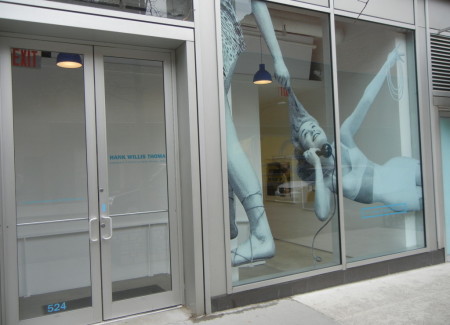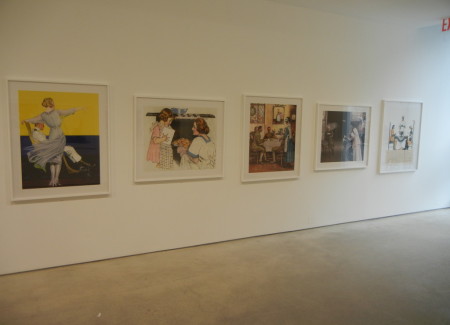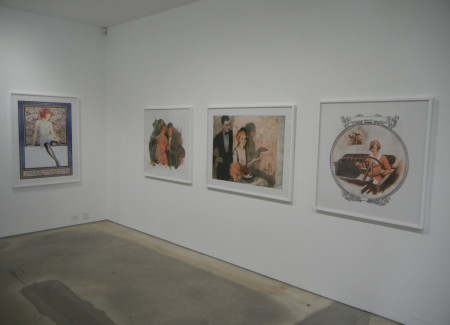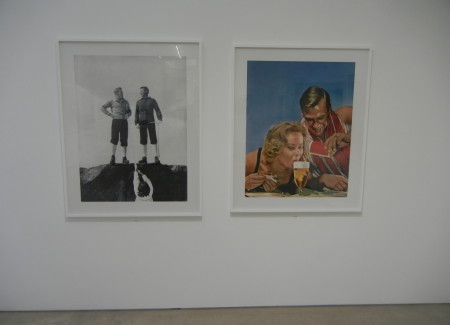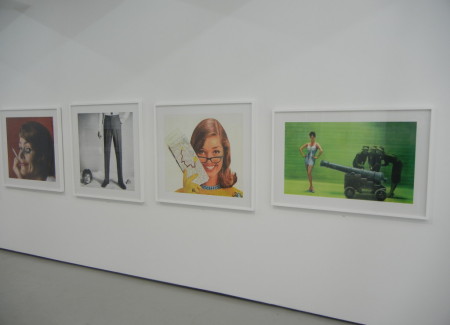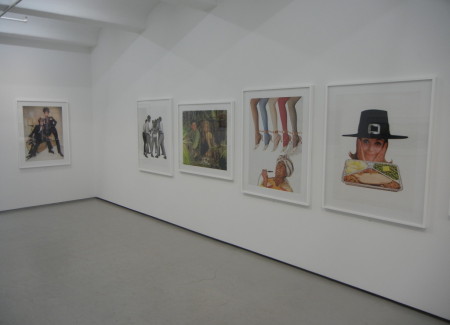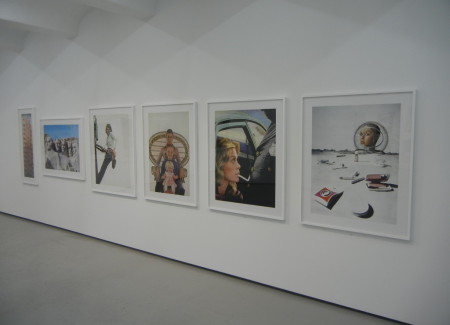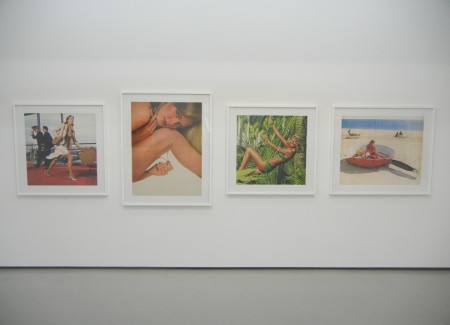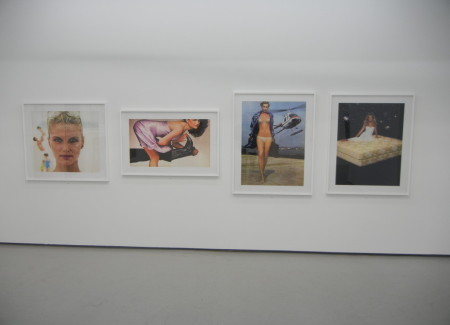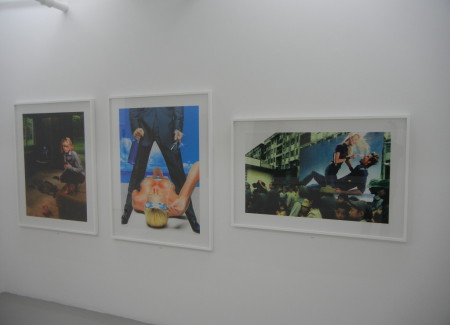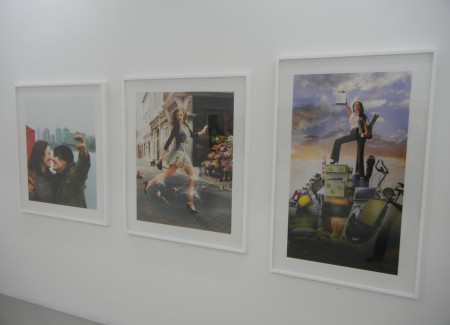JTF (just the facts): A total of 101 color photographs, framed in white and unmatted, and hung against white walls in the two rooms of the 24th Street space and the four rooms of the 20th Street space. All of the works are digital chromogenic prints, made in 2015. Physical sizes range from roughly 40×40 to 54×41 (or reverse), and all of the prints are available in editions of 3+2AP. A catalog of the exhibition has been published by the gallery and is available for $35. (Installation shots from both locations below.)
Comments/Context: Hank Willis Thomas’ new show is the first great exhibit of contemporary photography this year. (Stop a moment and take that statement in.) It is conceptually sophisticated, culturally rich and nuanced, and authentically (and often discouragingly) insightful. In short, it’s a thrilling knockout of a show. Finally, five months into the year, 2015 has its first milestone.
On view at both of the Jack Shainman Gallery locations, Unbranded: A Century of White Women, 1915-2015 follows up on Thomas’ earlier Unbranded: Reflections in Black by Corporate America, 1968-2008 project, leveraging a reductive appropriation style that had proven particularly powerful when he first applied it to decades of advertising depicting African-Americans. In both projects, Thomas has started with actual found advertising images (one from each specific year), which he has then carefully manipulated/Photoshopped to remove the logos, headlines, and body copy, leaving behind the underlying imagery, now isolated from its surrounding branding, messaging, and original context. And in both cases, the resulting works are often puzzlingly weird, haltingly inappropriate and sometimes ridiculous, and even quietly and provocatively disturbing – while they’ve been around us for years, it’s as if we’re really seeing them for the first time.
As much as we might like to, Thomas can’t be given full credit for inventing the conceptual approach he’s employed here. For that, we have to go back to the late 1970s and the collection of artists that became known as the Pictures Generation. At that time, deconstructing the motifs of advertising was top of mind (particularly playing with reworked combinations of text and imagery that had begun as ads), and quite a bit of work from that period (by James Welling, Sherrie Levine, Barbara Bloom, Robert Heinecken, David Salle, and others) was constructed by pulling apart and rebuilding advertising raw material to unpack its embedded truths. Richard Prince is perhaps Thomas’ most specific antecedent – Prince’s multi-image sets of watches, living rooms, and models looking left and right, and later of course his famous cowboys, are a direct link. In Prince’s images, commercial imagery is uprooted from its original context and reconsidered on its own, forcing us to see both the patterns in its creation and the underlying cultural freight it carries. His Marlboro cowboys are especially pregnant with layers of meaning, from the mythologies of the American West to the iconography of masculinity.
What Thomas can lay claim to is smartly reinvigorating this now decades old conceptual framework, and boldly rethinking it through the prisms of race, and in the current case, gender – he’s updated the arguments, and radically sharpened them with an alternate viewpoint. The works on view tell the story of a century of evolving female stereotypes (white women only), a single image drawn from each year from 1915 to 2015. The earliest images give us the woman as servant or caretaker – the cook, the housemaid, the woman looking for a ring, or the plucky, slightly dimwitted second to the man. Timid flirty (or subtly leering) innuendo becomes somewhat more obvious in succeeding years, and makeup, weight, aging/wrinkles, beauty, and wealth all have first appearances as things women are (or should be) thinking about. In the World War II years, we see the first images of women as independent figures (with careers outside the household), but these portrayals are always mixed with a bit of dismissiveness, as if being a soldier, a riveter, or a stewardess was simply a new form of seduction. By the 1950s, while the refrigerator offers a fleeting sense of freedom, the sexual winking in advertising gets more overt (phallic objects of all kinds, legs in the air) and the woman’s subservient place is still widely apparent, from a hair dragging Tarzan and Jane parody (where the woman is smilingly joyful at being yanked along the ground) to a woman hanging by a rope from a cliff while the men converse above, unaware of or uninterested in her predicament. Perhaps the creepiest part of this piling up of imagery is all the consistently smiling faces, the women apparently playing along with these various degradations as though it was happy fun.
This exhibition creates a roller coaster of reactions, from slapstick humor and head shaking goofiness to more insidious traps and appalled can’t-believe-it disgust, but it ultimately builds to an anthropological fascination with each image as a kind of individual time capsule – this is what advertisers thought women were, wanted to be, fantasized about, or represented (to themselves and to men) in any one year. Or maybe this is what advertisers made women into (without their consent) and conditioned society to believe. That idea is where Thomas’ images start to gain their bite; he exposes these roles and stereotypes for what they are – constructed cultural messages that carry all kinds of prejudicial baggage.
By the 1960s, glimmers of broader feminism and liberation start to appear with more frequency, from women dressing in men’s suits to the TV dinner for Thanksgiving, but they are always balanced by controls, conditions, power inequalities, and the hint of violence – the black eye loyalty, the chained harem, the caged cheetah print wildwoman, the woman in her underwear surrounded by men in clothes. A decade later, we see women repairing telecom equipment, racing through airports as executives, and swinging through the jungle with more authority – there’s even a woman on Mount Rushmore. But sex is never very far from the narrative, from the woman-sprawled-on-top mattress ads to the CEO in bra and panties (toting a briefcase with a helicopter in the background).
By the time the 1980s roll around, the advertisers seem to have gotten even wilier about their audiences, and the ads aimed at women and the ads aimed at men start to diverge more obviously, with women’s roles (and desires) evolving yet again into a new set of permutations. Overly sexualized women in bathing suits and skimpy outfits lounge around as exploitative eye candy for men, while others go to the office (leaving Mr. Mom behind), pump iron, and have their own secrets and ecstasies (without men). As the years pass, the power shift becomes clearer, from Kate Moss clearly knowing she is seducing voyeuristic men to Demi Moore fully ready, willing, and able to kick some ass. More and more images show women taking charge, both sexually and culturally – women physically on top of men, choosing their men (who can then take on the pregnancy duties!), pleasuring themselves, and having one night stands, while also playing tough muddy soccer and climbing to the top of metaphorical (and physical) pyramid of life. The last two images from 2014 and 2015 provide a fitting bookend to the project – a pair of happy lesbians taking a selfie, and a pickup truck full of curvy bikini-clad beauties reenacting Washington Crossing the Delaware. It seems to say that while some things do indeed change, and much progress has occurred, other realities remain stubbornly the same.
Part of Thomas’ anthropological exercise is to bring the “whiteness” of these women back into focus. There are no Latinas, or Asian women, or black women on view here (aside from for maids and mural beauties), and a spectrum of skin colors puts white on top. Even native peoples in jungles (who presumably have darker skin) have been replaced by white faces, the perky wholesomeness of Christie Brinkley being about as far from dark exoticism as advertisers could get. As the parade continues, it becomes clear that these pictures aren’t remotely representative of American women as a whole, but just a small sliver of carefully stereotyped white lifestyles.
While it isn’t entirely apparent unless you grab a checklist, Thomas also has a meaningful talent for textual wordplay, as found in the titles of his pictures. His phrases are full of acidic irony and witty punning, adding a layer of archly knowing commentary on top of the visuals themselves. Some even have an echo of Barbara Kruger’s incisive shouts and remarks – “Save his life and find your own”, “Blow it in her face and she’ll follow you anywhere”, “But she has other important uses as well”, “Firmness that feels good”, “Walk like a man”, “Just ripe enough”, and “This guy’s the limit”. The titles are like inside jokes that may or may not be entirely playful, like tiny jaded haikus that pointedly expose the absurdities Thomas is interested in revealing.
Seen together as one progression and as a contrast to Thomas’ previous project on the changing portrayal of African Americans in advertising, the White Women images provide a thought-provoking historical timeline of how women’s roles have been transformed over the past century – it’s a comprehensive visual history lesson, packing an enormous punch. What I like best is the sense of nuanced intelligence that pervades each and every picture – each one can be the starting point for a discussion or debate, each one an example that can lead to a myriad of complicated ideas and questions about both gender and race. Even in a world awash in imagery, Thomas’ artworks force us to rediscover the very real cultural power being wielded and delivered by advertising – there are durable markers and barriers buried under that seemingly benign surface, and his brilliantly cutting pictures shine fresh light on something we thought we already knew.
Collector’s POV: The prints on view in this show are priced at $15000 each. Surprisingly, Hank Willis Thomas’ work has very little secondary market history. As a result, gallery retail remains the best option for those collectors interested in following up.
